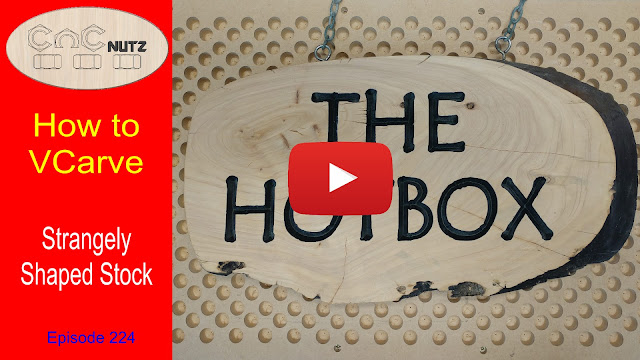Have you ever been given a strangely shaped piece of wood and been asked to machine it?
This is exactly the sort of job I designed my vacuum table to handle. A piece of material shaped such that my standard hold downs will not clamp it and since I really need to flatten the wood I can't have the clamps on top anyway as they would get damaged.
Well that is the senario I encountered this week. I need to flatten my wood and position the lettering on it such that it is centered and look correct. Given the shape of the wood this is not obvious at first glance and simply putting my letters in the center would not work. I needed another way of aligning everything.
This is the method I choose.
The Results
It came out as expected with the lettering in the center of the material as planned. Using a photo to get alignment is a good way of getting alignment but you need to keep your wits about you. Set up a reference vector like my oval and scale your photo to this vector. Make sure the vector position does not move with respect to the origin point and select an origin that you can easily locate on the material. It could be sonething as an X that you mark on the material before you take the photo. So long as you have a reference point that you can set your cutter to. After that position your engraving to suit the photo and not the reference vector. the rest is plian sailing.
Software
For this project either VCarve Pro or Aspire from Vectric could have been used. I used Aspire for this one.
The HOTBOX
so what is the HotBox?
I'm not sure what it is called in other countries but here it is called a Bach or a Crib or at a pinch a holiday home though it lacks the creature comforts you would normally expect while on holiday. The name comes from the basic box shape and the fact that it used a coal range for cooking and heating. Given the fach that it is small and the coal range put out massive amounts of heat you are left with a hot box. As I was growing up I spent most of my holidays here in the middle of nowhere, Surf Casting, rounding up sheep and anything else that was needed.
My work here is done so until next time have a good day.
Cheers
Peter
When I started my CNC adventure about 10 years ago I didn't understand Climb and conventional cuts. To be honest I still don't to a certain extent. I understand how to tell the difference between the two, I understand that the direction of cut can have good and bad effects on the finish of my cuts. I have read up on the subject and tried to learn as much as I can but at the end of the day it is the observations that I have made while playing with my machine that ultimately determines which machining strategy I choose.
In my testing with cut direction I have always found that conventional cuts give me the best results. Now to be clear my observations are related to cutting wood and wood products like plywood. I m not talking about cutting metal which is a whole other subject that is out of my realm of experience. It is also fair to say that most of what I have read is related to metal work. Even the small amount of aluminium and steel cutting I have done on my CNC was done as conventional cuts and I did not do any testing to see if changing machining strategy would help. I was just happy to see it cut.
Conculsion
The list of climb cut advantages over conventional is long and at first glance it is hard to see why anyone would want to use conventional at all.
- Smaller chip load.
- Chip thinning reduces heating at the cutter and the load reduces as the cut progresses.
- Chip ejection behind the cut prevents recutting of the chips.
- Longer tool life due to lower stress and less heat.
- The cutter slices into the the material reducing the likely hood of chipout
- Better cut quality?
The only thing I have problems with is the last item on the list. When cutting in wood I have not experienced better cut quality. It could be that I run my cutter too quick for climb cuts but why run it slow when conventional cuts do a good job running faster. Maybe the climb cut should be used as a final pass at a slow feedrate.
I would really like to hear from you and whether you have sucess with climb cutting in wood. It would be good to compare my results with what others have experienced.
It is always possible that I have been using climb cut wrong all these years and hopefully will learn something new.
Leave a comment below or on the video.
I look forward to reading the comments.
Cheers
Peter





